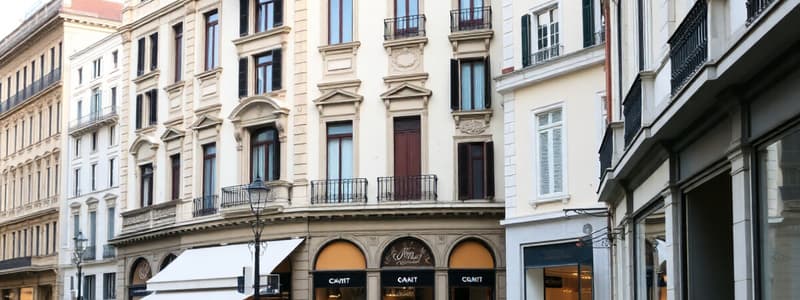Podcast
Questions and Answers
Milan's famous street for high-end fashion boutiques is called ______.
Milan's famous street for high-end fashion boutiques is called ______.
Via Montenapoleone
The street that connects the Duomo and the Navigli district is ______.
The street that connects the Duomo and the Navigli district is ______.
Via Torino
Corso Buenos Aires is one of the longest shopping streets in ______.
Corso Buenos Aires is one of the longest shopping streets in ______.
Europe
The ______ district is renowned for its network of canals and historical significance.
The ______ district is renowned for its network of canals and historical significance.
Public art installations can be found throughout the city, enhancing its cultural ______.
Public art installations can be found throughout the city, enhancing its cultural ______.
Flashcards are hidden until you start studying
Study Notes
Overview of the Streets of Milan
- Milan is known for its blend of historical and modern architecture, reflected in its streets.
- The city layout is organized, with a mix of narrow alleys and wide boulevards.
Major Streets
-
Via Montenapoleone
- Famous for high-end fashion boutiques and luxury brands.
- Central to Milan's "Fashion District."
-
Corso Como
- Known for its modern shops, bars, and restaurants.
- Features the famous 10 Corso Como concept store.
-
Via della Spiga
- Another key street in the Fashion District.
- Home to prestigious fashion houses.
-
Corso Buenos Aires
- One of the longest shopping streets in Europe.
- Offers a mix of international brands and Italian stores.
-
Via Torino
- A vibrant street connecting the Duomo and the Navigli district.
- Features a mix of shops, cafes, and restaurants.
Historical Significance
- Many streets trace the city's Roman origins and medieval heritage.
- The Navigli district, with its network of canals, dates back to the 12th century.
- Piazza del Duomo serves as a central hub, with adjacent streets radiating outward.
Cultural Aspects
- Streets often host local markets, festivals, and cultural events.
- Public art and installations can be found throughout the city.
Transportation
- Milan has a comprehensive public transportation system, including trams and buses.
- Walking and cycling are popular for navigating the city center.
Notable Features
- The architecture varies from Gothic (e.g., the Duomo) to modern (e.g., skyscrapers in Porta Nuova).
- Many streets are pedestrian-friendly, enhancing the city's walkability.
Tips for Exploration
- Start at the Duomo and explore surrounding streets for a mix of culture and commerce.
- Visit during fashion weeks for a unique experience in Milan's fashion hubs.
- Take advantage of cafes and restaurants to experience local cuisine while exploring the streets.
Milan's Streets: A Blend of History and Modernity
-
Milan's streets are a unique blend of historical and modern architecture, showcasing the city's evolution.
-
The city's layout is organized with a mix of narrow alleys and wide boulevards.
Major Streets
- Via Montenapoleone: Home to high-end fashion boutiques and luxury brands, situated within Milan's "Fashion District."
- Corso Como: Known for its modern shops, bars, and restaurants, featuring the famous 10 Corso Como concept store.
- Via della Spiga: Another key street in the Fashion District, home to prestigious fashion houses.
- Corso Buenos Aires: One of the longest shopping streets in Europe with a mix of international brands and Italian stores.
- Via Torino: A vibrant street connecting the Duomo and the Navigli district, offering shops, cafes, and restaurants.
Historical Significance
- Many streets reflect Milan's Roman origins and medieval heritage.
- The Navigli district, with its network of canals, dates back to the 12th century.
- Piazza del Duomo serves as a central hub with streets radiating outward from it.
Cultural Aspects
- Local markets, festivals, and cultural events are often held on the streets of Milan.
- Public art and installations can be found throughout the city.
Transportation
- Milan boasts a comprehensive public transportation system, including trams and buses.
- Walking and cycling are popular ways to get around the city center.
Notable Features
- The architecture ranges from Gothic, exemplified by the Duomo, to modern, seen in the skyscrapers of Porta Nuova.
- Many streets are pedestrian-friendly, promoting the city's walkability.
Tips for Exploration
- Start at the Duomo and explore surrounding streets for a mix of culture and commerce.
- Consider a visit during fashion weeks for a unique experience in Milan’s fashion hubs.
- Embrace the local cuisine by enjoying cafes and restaurants while exploring the streets.
Studying That Suits You
Use AI to generate personalized quizzes and flashcards to suit your learning preferences.





